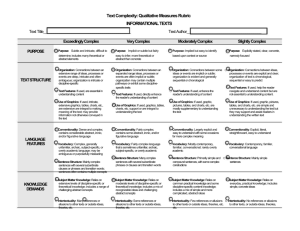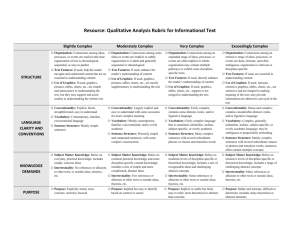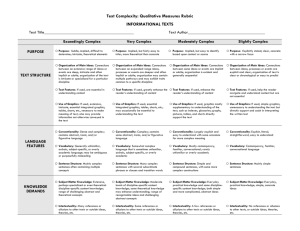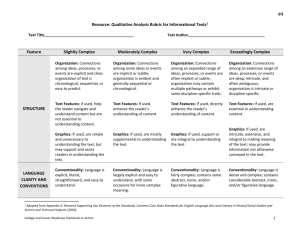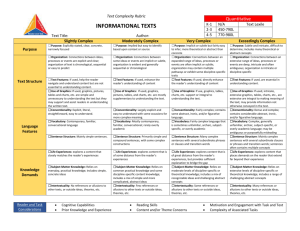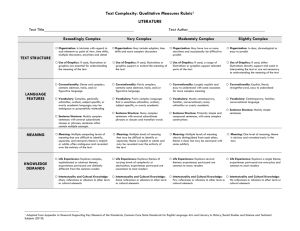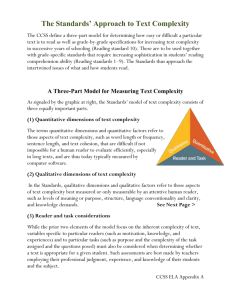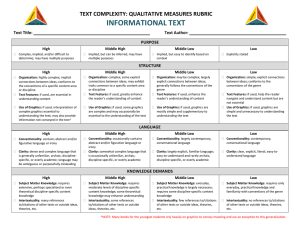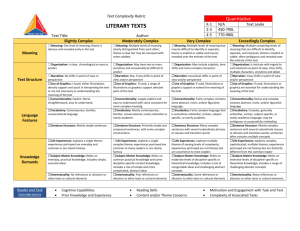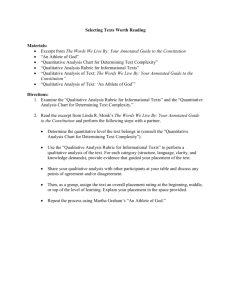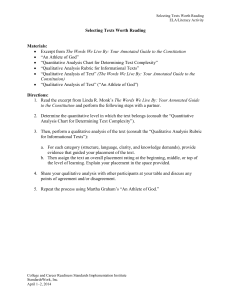Informational Text Complexity: Qualitative Measures
advertisement
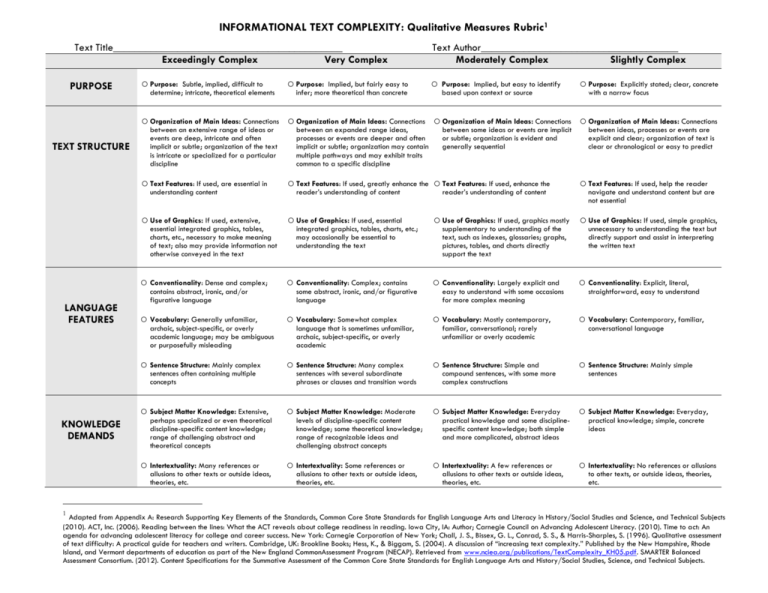
INFORMATIONAL TEXT COMPLEXITY: Qualitative Measures Rubric1 Text Title___________________________________________ Exceedingly Complex Very Complex PURPOSE o Purpose: Subtle, implied, difficult to determine; intricate, theoretical elements o Purpose: Implied, but fairly easy to infer; more theoretical than concrete Text Author_____________________________________ Moderately Complex Slightly Complex o Purpose: Implied, but easy to identify based upon context or source o Purpose: Explicitly stated; clear, concrete with a narrow focus o Organization of Main Ideas: Connections o Organization of Main Ideas: Connections o Organization of Main Ideas: Connections o Organization of Main Ideas: Connections TEXT STRUCTURE between an extensive range of ideas or events are deep, intricate and often implicit or subtle; organization of the text is intricate or specialized for a particular discipline o Use of Graphics: If used, extensive, o Use of Graphics: If used, essential o Use of Graphics: If used, graphics mostly o Use of Graphics: If used, simple graphics, o Conventionality: Dense and complex; o Conventionality: Complex; contains o Conventionality: Largely explicit and o Conventionality: Explicit, literal, o Vocabulary: Generally unfamiliar, o Vocabulary: Somewhat complex o Vocabulary: Mostly contemporary, o Vocabulary: Contemporary, familiar, o Sentence Structure: Mainly complex o Sentence Structure: Many complex o Sentence Structure: Simple and o Sentence Structure: Mainly simple o Subject Matter Knowledge: Extensive, o Subject Matter Knowledge: Moderate o Subject Matter Knowledge: Everyday o Subject Matter Knowledge: Everyday, o Intertextuality: Many references or o Intertextuality: Some references or o Intertextuality: A few references or o Intertextuality: No references or allusions contains abstract, ironic, and/or figurative language archaic, subject-specific, or overly academic language; may be ambiguous or purposefully misleading sentences often containing multiple concepts perhaps specialized or even theoretical discipline-specific content knowledge; range of challenging abstract and theoretical concepts allusions to other texts or outside ideas, theories, etc. 1 between ideas, processes or events are explicit and clear; organization of text is clear or chronological or easy to predict o Text Features: If used, greatly enhance the o Text Features: If used, enhance the essential integrated graphics, tables, charts, etc., necessary to make meaning of text; also may provide information not otherwise conveyed in the text KNOWLEDGE DEMANDS between some ideas or events are implicit or subtle; organization is evident and generally sequential o Text Features: If used, are essential in understanding content LANGUAGE FEATURES between an expanded range ideas, processes or events are deeper and often implicit or subtle; organization may contain multiple pathways and may exhibit traits common to a specific discipline reader’s understanding of content integrated graphics, tables, charts, etc.; may occasionally be essential to understanding the text some abstract, ironic, and/or figurative language language that is sometimes unfamiliar, archaic, subject-specific, or overly academic sentences with several subordinate phrases or clauses and transition words levels of discipline-specific content knowledge; some theoretical knowledge; range of recognizable ideas and challenging abstract concepts allusions to other texts or outside ideas, theories, etc. reader’s understanding of content supplementary to understanding of the text, such as indexes, glossaries; graphs, pictures, tables, and charts directly support the text easy to understand with some occasions for more complex meaning familiar, conversational; rarely unfamiliar or overly academic compound sentences, with some more complex constructions practical knowledge and some disciplinespecific content knowledge; both simple and more complicated, abstract ideas allusions to other texts or outside ideas, theories, etc. o Text Features: If used, help the reader navigate and understand content but are not essential unnecessary to understanding the text but directly support and assist in interpreting the written text straightforward, easy to understand conversational language sentences practical knowledge; simple, concrete ideas to other texts, or outside ideas, theories, etc. Adapted from Appendix A: Research Supporting Key Elements of the Standards, Common Core State Standards for English Language Arts and Literacy in History/Social Studies and Science, and Technical Subjects (2010). ACT, Inc. (2006). Reading between the lines: What the ACT reveals about college readiness in reading. Iowa City, IA: Author; Carnegie Council on Advancing Adolescent Literacy. (2010). Time to act: An agenda for advancing adolescent literacy for college and career success. New York: Carnegie Corporation of New York; Chall, J. S., Bissex, G. L., Conrad, S. S., & Harris-Sharples, S. (1996). Qualitative assessment of text difficulty: A practical guide for teachers and writers. Cambridge, UK: Brookline Books; Hess, K., & Biggam, S. (2004). A discussion of “increasing text complexity.” Published by the New Hampshire, Rhode Island, and Vermont departments of education as part of the New England CommonAssessment Program (NECAP). Retrieved from www.nciea.org/publications/TextComplexity_KH05.pdf. SMARTER Balanced Assessment Consortium. (2012). Content Specifications for the Summative Assessment of the Common Core State Standards for English Language Arts and History/Social Studies, Science, and Technical Subjects.
